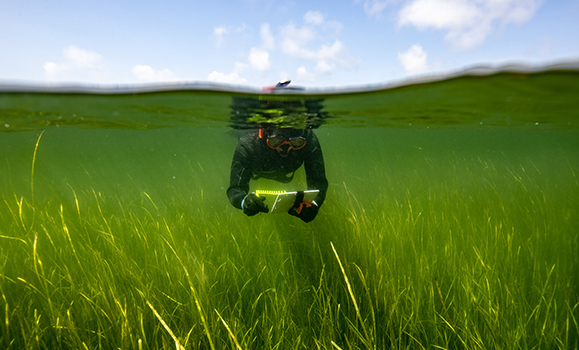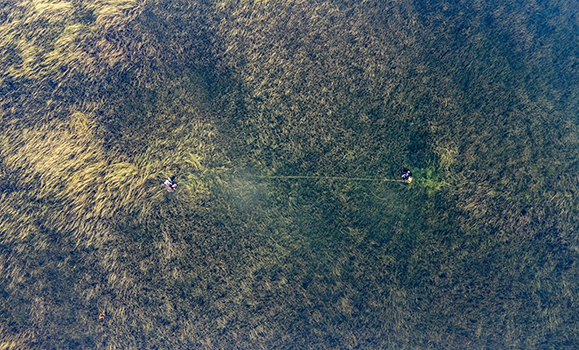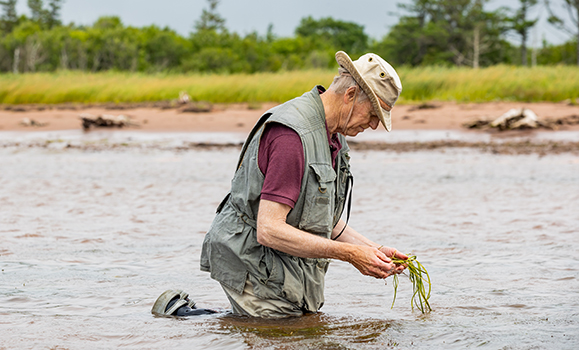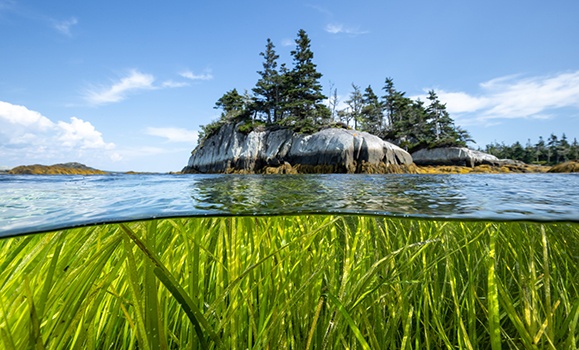The ocean is one of EarthÔÇÖs largest and most effective carbon sinks. With every wave, carbon is collected from the atmosphere, stored in marine life, plants, sediments and more ÔÇö known as blue carbon.┬á
, a scientist at H┬■╗ş, is researching eelgrass and its importance to Atlantic CanadaÔÇÖs blue-carbon stores.┬á
The project, ÔÇťEstablishing the value of blue carbon to Nova Scotia: a case study,ÔÇŁ involves researching why eelgrass is disappearing and how it can be restored. This project is supported financially through the , which has enabled the initiative to blossom and thrive.┬á
Exploring eelgrass in Atlantic Canada
Eelgrass, known by its scientific name Zostera marina, is a unique species of seagrass. It is the only marine plant with both shoots and rhizomes that live completely under the water. In Atlantic Canada, eelgrass species are found in underwater meadows along coastlines where they thrive in the shallow waters and soft sediments.
Dr. Boerder and research partners at Dal began exploring eelgrass in 2020.
ÔÇťWe paddled and snorkeled around [Owls Head] and found these lush, dense, healthy eelgrass meadows,ÔÇŁ says Dr. Boerder. ÔÇťI've snorkeled in a couple [meadows] around Nova Scotia, but I had never seen something like that.ÔÇŁ
 Researchers exploring the eelgrass meadows in OwlÔÇÖs Head, Nova Scotia. (CERI, photo taken by Nicolas Winkler Photography)
Researchers exploring the eelgrass meadows in OwlÔÇÖs Head, Nova Scotia. (CERI, photo taken by Nicolas Winkler Photography)
In the ocean, seagrasses are responsible for storing nearly 10 per cent of the worldÔÇÖs carbon each year, even though they cover a mere 0.2 per cent of the ocean floor. The carbon travels through their roots and into the sediment, where carbon can accumulate vertically as the sea level rises ÔÇö meaning seagrasses can continue to sequester carbon indefinitely if undisturbed.┬á
A restoration initiative
 Despite the ample eelgrass presence along Nova ScotiaÔÇÖs coastline, the amount of carbon it sequesters has yet to be quantified.┬áCommunity Eelgrass Restoration Initiative (CERI) was established to help fill this knowledge gap and explore why eelgrass is disappearing around the province.
Despite the ample eelgrass presence along Nova ScotiaÔÇÖs coastline, the amount of carbon it sequesters has yet to be quantified.┬áCommunity Eelgrass Restoration Initiative (CERI) was established to help fill this knowledge gap and explore why eelgrass is disappearing around the province.
The project initially began with groups of volunteers and was funded through small grants from organizations like the and the .
The OFI seed fund provided the foundation for the establishment of CERI and its research abilities by funding new research equipment, labs and training. CERI now has over 12 research sites across Nova Scotia, New Brunswick, and Prince Edward Island.
ÔÇťBy the third year, the OFI seed fund kicked in and that is what really enabled us,ÔÇŁ says Dr. Boerder. ÔÇťIt was the first meaningful amount of funding that allowed us to plan in a proper scientific way.ÔÇŁ
 Scientists mapping the dense eelgrass meadows of Nova Scotia. (CERI, photo taken by Nicolas Winkler Photography)
Scientists mapping the dense eelgrass meadows of Nova Scotia. (CERI, photo taken by Nicolas Winkler Photography)
CERI has four main initiatives throughout their project: mapping eelgrass locations; easuring eelgrass carbon sequestration; restoring eelgrass meadows; outreach and education.
Currently, CERI is focusing on restoring meadows around Nova Scotia. There is a lack of knowledge regarding the provinceÔÇÖs eelgrass meadows. Researchers do not know how many meadows the province has already lost.┬á
However, this novel eelgrass and sediment research is adding vital information to the growing scientific database, putting Nova Scotia on the map for its world-class ocean research.
A community effort
The project relies heavily on citizen scientists in communities to help gather knowledge and stories of past eelgrass meadows.
The team is heavily centered on a two-eyed seeing approach, ensuring that the H┬■╗ş researchers are an equal partner with the Confederacy of Mainland MiÔÇÖkmaq.
 Community member participating in an eelgrass replanting workshop in Prince Edward Island. (CERI, photo taken by Nicolas Winkler Photography)
Community member participating in an eelgrass replanting workshop in Prince Edward Island. (CERI, photo taken by Nicolas Winkler Photography)
ÔÇťHaving such a diverse and engaged team really helps because the ideas and creativity with that is really helpful and inspiring to see,ÔÇŁ says Dr. Boerder.
To accomplish its restoration goals, CERI is working with communities across Nova Scotia to replant damaged eelgrass meadows. 
ÔÇťWe see that people really want to be part of a solution,ÔÇŁ says Dr. Boerder. ÔÇťIn Nova Scotia, we use it like a gateway into marine conservation and restoration, which nearly every member of the public that I speak to has no idea that it's possible.ÔÇŁ
Learn about other active and completed .

